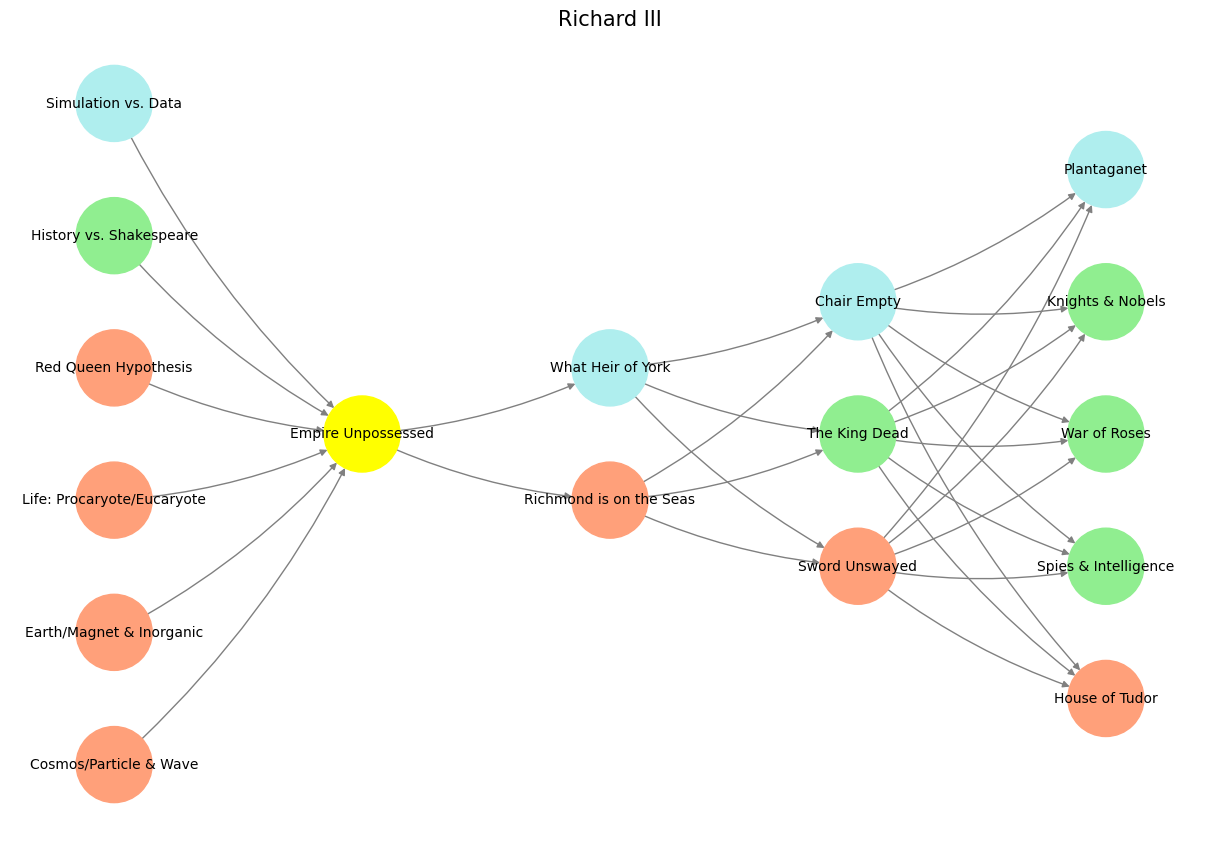Engineering#
Is the chair empty? Is the sword unswayed?
Is the King dead? The empire unpossessed?
What heir of York is there alive but we?
And who is England’s King but great York’s heir?
Then tell me, what makes he upon the seas?
– Richard III
This excerpt from Richard III brims with urgency, paranoia, and Richard’s desperate grasp on power. Let’s dissect the scene, its themes, and its rhetorical brilliance in the context of Shakespeare’s motifs:
1. Stanley’s Diplomacy: A Balancing Act#
Stanley’s opening lines—“None good, my liege, to please you with the hearing; / Nor none so bad but well may be reported”—are a masterpiece of equivocation. They reflect his precarious position, caught between Richard’s tyrannical demands and the growing rebellion. This is diplomacy under duress: delivering bad news with a veneer of neutrality. It mirrors the broader tension in the play between loyalty and survival.
2. Richard’s Frustration: A Descent into Tyranny#
Richard’s reply, “Hoyday, a riddle! Neither good nor bad,” reveals his intolerance for ambiguity. He demands directness, which underscores his obsession with control. Yet his impatience also betrays insecurity—Richard knows his grip on the throne is fragile, and every piece of news is a potential threat.
His rhetorical question, “What need’st thou run so many miles about / When thou mayst tell thy tale the nearest way?” contrasts Stanley’s caution with Richard’s blunt force approach. This contrast foreshadows Richard’s downfall: diplomacy and subtlety are beyond him, replaced by brute assertions of power.
3. Richmond as Destiny: The Unstoppable Tide#
Stanley’s revelation—“Richmond is on the seas”—introduces the play’s harbinger of justice and renewal. The imagery of Richmond at sea evokes fluidity and inevitability; the rebellion is no longer a rumor but a force of nature. For Richard, the seas are not just physical waters but a metaphysical tide carrying his doom.
Richard’s furious retort, “There let him sink, and be the seas on him!” encapsulates his tyrannical delusion: he views himself as capable of commanding nature itself. Yet his curse rings hollow, revealing his powerlessness against Richmond’s rise.
4. The Rhetoric of Power and Legitimacy#
Richard’s interrogation—“Is the chair empty? Is the sword unswayed? / Is the King dead? The empire unpossessed?”—is a striking litany of rhetorical questions. Each item reflects a symbol of monarchy:
The chair empty: The throne, symbol of sovereign authority.
The sword unswayed: The power to enforce rule and protect the realm.
The King dead: The physical presence of a monarch.
The empire unpossessed: The land and subjects who make up the kingdom.
Richard frames these questions as rhetorical assertions, reinforcing his claim to legitimacy. Yet the repetition also hints at his own doubts—why assert these things if they were unchallenged truths? His words are a desperate attempt to hold his crumbling self-image together.
5. The Irony of Richard’s Self-Certainty#
“What heir of York is there alive but we? / And who is England’s King but great York’s heir?” These lines reveal Richard’s hubris and tunnel vision. In his mind, his lineage alone legitimizes his rule, ignoring the moral, legal, and political dimensions of kingship. His dismissal of Richmond’s claim as a baseless rebellion underscores his inability to see himself as a usurper, despite having seized the throne through murder and deceit.
6. Themes of Usurpation and Restoration#
Richmond’s advance symbolizes the restoration of rightful order, a recurring theme in Shakespeare’s histories. Richard’s tyrannical reign—founded on blood and treachery—is antithetical to the ideals of kingship. His repeated rhetorical questions emphasize his belief in divine right, yet his actions defy the moral and cosmic order that such a right entails. Richmond, by contrast, embodies the natural, lawful progression of power.
7. Symbolism of the Sea#
The sea serves as a multifaceted symbol:
For Richmond, it represents a path to destiny, fluid and unstoppable.
For Richard, it is chaos and instability—he cannot master it, much as he cannot master the forces rising against him.
Conclusion#
This passage is a microcosm of the entire play: Richard’s delusions of grandeur, his tyrannical rage, and his inability to recognize the forces arrayed against him. Richmond’s arrival on the seas signals the tide of justice and inevitability, while Stanley’s cautious diplomacy reflects the precarious balancing act of those caught between tyranny and rebellion. Shakespeare’s rhetorical mastery shines here, with Richard’s interrogations functioning as both assertions of power and unintentional revelations of doubt. It’s a brilliant collision of character, theme, and dramatic tension.
Show code cell source
import numpy as np
import matplotlib.pyplot as plt
import networkx as nx
# Define the neural network structure; modified to align with "Aprés Moi, Le Déluge" (i.e. Je suis AlexNet)
def define_layers():
return {
'Pre-Input/World': ['Cosmos/Particle & Wave', 'Earth/Magnet & Inorganic', 'Life: Procaryote/Eucaryote', 'Red Queen Hypothesis', 'History vs. Shakespeare', 'Simulation vs. Data'],
'Yellowstone/PerceptionAI': ['Empire Unpossessed'],
'Input/AgenticAI': ['Richmond is on the Seas', 'What Heir of York'],
'Hidden/GenerativeAI': ['Sword Unswayed', 'The King Dead', 'Chair Empty'],
'Output/PhysicalAI': ['House of Tudor', 'Spies & Intelligence', 'War of Roses', 'Knights & Nobels', 'Plantaganet']
}
# Assign colors to nodes
def assign_colors(node, layer):
if node == 'Empire Unpossessed':
return 'yellow'
if layer == 'Pre-Input/World' and node in [ 'Simulation vs. Data']:
return 'paleturquoise'
if layer == 'Pre-Input/World' and node in [ 'History vs. Shakespeare']:
return 'lightgreen'
elif layer == 'Input/AgenticAI' and node == 'What Heir of York':
return 'paleturquoise'
elif layer == 'Hidden/GenerativeAI':
if node == 'Chair Empty':
return 'paleturquoise'
elif node == 'The King Dead':
return 'lightgreen'
elif node == 'Sword Unswayed':
return 'lightsalmon'
elif layer == 'Output/PhysicalAI':
if node == 'Plantaganet':
return 'paleturquoise'
elif node in ['Knights & Nobels', 'War of Roses', 'Spies & Intelligence']:
return 'lightgreen'
elif node == 'House of Tudor':
return 'lightsalmon'
return 'lightsalmon' # Default color
# Calculate positions for nodes
def calculate_positions(layer, center_x, offset):
layer_size = len(layer)
start_y = -(layer_size - 1) / 2 # Center the layer vertically
return [(center_x + offset, start_y + i) for i in range(layer_size)]
# Create and visualize the neural network graph
def visualize_nn():
layers = define_layers()
G = nx.DiGraph()
pos = {}
node_colors = []
center_x = 0 # Align nodes horizontally
# Add nodes and assign positions
for i, (layer_name, nodes) in enumerate(layers.items()):
y_positions = calculate_positions(nodes, center_x, offset=-len(layers) + i + 1)
for node, position in zip(nodes, y_positions):
G.add_node(node, layer=layer_name)
pos[node] = position
node_colors.append(assign_colors(node, layer_name))
# Add edges (without weights)
for layer_pair in [
('Pre-Input/World', 'Yellowstone/PerceptionAI'), ('Yellowstone/PerceptionAI', 'Input/AgenticAI'), ('Input/AgenticAI', 'Hidden/GenerativeAI'), ('Hidden/GenerativeAI', 'Output/PhysicalAI')
]:
source_layer, target_layer = layer_pair
for source in layers[source_layer]:
for target in layers[target_layer]:
G.add_edge(source, target)
# Draw the graph
plt.figure(figsize=(12, 8))
nx.draw(
G, pos, with_labels=True, node_color=node_colors, edge_color='gray',
node_size=3000, font_size=10, connectionstyle="arc3,rad=0.1"
)
plt.title("Richard III", fontsize=15)
plt.show()
# Run the visualization
visualize_nn()


Fig. 8 Agent AI Nvidia Vision & Test-Time Scaling. Here’s a scheme: user or machine (yellow node) -> prompt/response -> agent AI -> [plan/monumental, tool use/antiquarian, critique/critical] -> [Calculator, Web Search, Semantic Search, SQL Search, Generate Podcast]#

